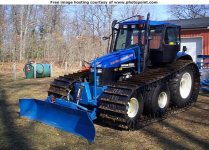I agree, it doesn't make sense and I think now I've REALLY figured this out, but first....
Glenn, my appologies for taking this discussion off course, but it's too puzzling a question for me to resist. I guess we've gotten "side tracked" - yuk, yuk, yuk. But all jokes aside, this would in fact make a great extra credit question for a Mechanical Engineering exam.
Now back to the problem. I now believe that not only is the "It's a Bigger Wheel" model incorrect, but I believe my "It's two ovals" model is ALSO incorrect. The real answer comes from looking more closely at the problem and seeing that it's neither circles nor ovals, but that a track changes shape as it goes around.
Let's look at the same example where we have two equal sized drive wheels of 1' diameter, spaced 2' center to center, with a 1' thick track wrapped around. Now let's look at the track's shape and distances around the inner and outer surfaces.
The track can be broken into two parts, that which is in contact with the wheel, and that which is running straight between the wheels. The sections in contact with the wheels are two half circles, one forward of the front axle, and the other rearward or the rear axle. In these sections, the inner track surface length is 1/2 of the wheel circumference, or 1.57'. The outer track surface is 1/2 of the wheel circumference plus 2x the track thickness, or 9.41/2 => 4.71'. The outer length is considerably longer than the inner length.
Now look at the sections of track between the axles where the track is not in contact with the wheels. Each of these sections (one top and one bottom) is 2' long, and for both of these sections the inner track surface is exactly the same length as the outer track surface.
Now, how is this so? Well, as the track goes around, the outer surface expands as it goes around the wheel, and the expanded outer surface is indeed moving faster than the inner surface, BUT IT"S NOT IN CONTACT WITH THE GROUND! Ground contact occurs only between the two axels, and in that section the inner and outer lengths are exactly the same.
So, I now believe that a trackless vehicle (just drive wheels) will travel EXACTLY the same distance per drive wheel revolution as a tracked vehicle with the same drive wheels, and it will do this regardless of the track thickness. This is because the section of track in contact with the ground is always the same length as the inner track section covered by the drive wheel rotation.
The "Bigger wheel" model does not work because the bigger wheel is never in contact with the ground. The "concentric Oval" model is wrong too because the longer part of the outer surface is also never in contact with the ground.
To summarize, as a track goes around, the length in contact with the ground is exactly the same as the length that came in contact with the drive wheels. As the track leaves contact with the ground at the exact same time that is makes contact with the wheel, and for the whole time it's in contact with the wheel the outer surface of the track expands, either by stretching in the case of a belt, or "fanning out" as in the case of a metal track. The outer surface is moving much faster as it goes around the wheel, then slows back down to the drive wheel speed once it leaves contact with the wheel. If you watch a track you can clearly see this speed change.
A track is exactly like having a person walking in front of the vehicle doing just-in-time road construction (of any thickness) while someone else is walking behind doing just-in-time road destruction and passing the removed material forward to the road builder guy. The tractor speed and leverage is completely unchanged with the addition of tracks, just as the thickness of a road surface does not alter speed or leverage.
I also retract my assertion that wider wheel spacing changes things. It changes nothing.
I think this now makes sense. Does anyone else agree (or care)?


